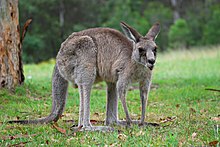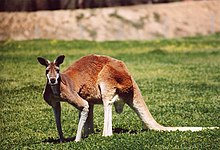| Kangaroos Temporal range: Early Miocene – Present
| |
|---|---|

| |
| A female eastern grey kangaroo | |
| Scientific classification | |
| Domain: | Eukaryota |
| Kingdom: | Animalia |
| Phylum: | Chordata |
| Class: | Mammalia |
| Infraclass: | Marsupialia |
| Order: | Diprotodontia |
| Suborder: | Macropodiformes |
| Family: | Macropodidae |
| Groups included | |
| Cladistically included but traditionally excluded taxa | |
| |


Kangaroos are marsupials from the family Macropodidae (macropods, meaning "large foot"). In common use the term is used to describe the largest species from this family, the red kangaroo, as well as the antilopine kangaroo, eastern grey kangaroo, and western grey kangaroo.[1] Kangaroos are indigenous to Australia and New Guinea. The Australian government estimates that 42.8 million kangaroos lived within the commercial harvest areas of Australia in 2019, down from 53.2 million in 2013.[2]
As with the terms "wallaroo" and "wallaby", "kangaroo" refers to a paraphyletic grouping of species. All three terms refer to members of the same taxonomic family, Macropodidae, and are distinguished according to size. The largest species in the family are called "kangaroos" and the smallest are generally called "wallabies". The term "wallaroos" refers to species of an intermediate size.[3] There are also the tree-kangaroos, another type of macropod, which inhabit the tropical rainforests of New Guinea, far northeastern Queensland and some of the islands in the region. This kind of kangaroo lives in the upper branches of trees.[4] A general idea of the relative size of these informal terms could be:
- wallabies: head and body length of 45–105 cm and tail length of 33–75 cm; the dwarf wallaby (the smallest of all known macropod species) is 46 cm long and weighs 1.6 kg;
- tree-kangaroos: ranging from Lumholtz's tree-kangaroo: body and head length of 48–65 cm, tail of 60–74 cm, weight of 7.2 kg (16 lb) for males and 5.9 kg (13 lb) for females; to the grizzled tree-kangaroo: length of 75–90 cm (30 to 35 in) and weight of 8–15 kg (18–33 lb);
- wallaroos: the black wallaroo (the smaller of the two species) with a tail length of 60–70 cm and weight of 19–22 kg (41.8–48.5 lb) for males and 13 kg (28.6 lb) for females;
- kangaroos: a large male can be 2 m (6 ft 7 in) tall and weigh 90 kg (200 lb).
Kangaroos have large, powerful hind legs, large feet adapted for leaping, a long muscular tail for balance, and a small head. Like most marsupials, female kangaroos have a pouch called a marsupium in which joeys complete postnatal development.
Because of its grazing habits, the kangaroo has developed specialized teeth that are rare among mammals. Its incisors are able to crop grass close to the ground and its molars chop and grind the grass. Since the two sides of the lower jaw are not joined or fused together, the lower incisors are farther apart, giving the kangaroo a wider bite. The silica in grass is abrasive, so kangaroo molars are ground down and they actually move forward in the mouth before they eventually fall out, and are replaced by new teeth that grow in the back.[5] This process is known as polyphyodonty and, amongst other mammals, only occurs in elephants and manatees.
The large kangaroos have adapted much better than the smaller macropods to land clearing for pastoral agriculture and habitat changes brought to the Australian landscape by humans. Many of the smaller species are rare and endangered, while kangaroos are relatively plentiful, despite a common misconception to the contrary.[6][7]
The kangaroo along with the koala are symbols of Australia. A kangaroo appears on the Australian coat of arms[8] and on some of its currency,[9] and is used as a logo for some of Australia's most well-known organisations, such as Qantas,[10] and as the roundel of the Royal Australian Air Force.[11] The kangaroo is important to both Australian culture and the national image, and consequently there are numerous popular culture references.
Wild kangaroos are shot for meat, leather hides, and to protect grazing land.[12] Kangaroo meat has perceived health benefits for human consumption compared with traditional meats due to the low level of fat on kangaroos.[13]
- ^ Groves, C. P. (2005). Wilson, D. E.; Reeder, D. M. (eds.). Mammal Species of the World: A Taxonomic and Geographic Reference (3rd ed.). Baltimore: Johns Hopkins University Press. p. 64 & 66. ISBN 0-801-88221-4. OCLC 62265494.
- ^ "Kangaroo population estimates" (PDF). Wildlife Trade. Government of Australia: Department Agriculture, Water and the Environment. Archived (PDF) from the original on 25 July 2021. Retrieved 30 July 2021.
- ^ Cite error: The named reference
Australian Wildlifewas invoked but never defined (see the help page). - ^ "Live Science article". Live Science. 2 March 2016. Archived from the original on 14 November 2021. Retrieved 14 November 2021.
- ^ Kangaroo: the teeth Archived 17 April 2014 at the Wayback Machine
- ^ Foley, Meraiah (26 November 2008). "Save the environment - eat kangaroo, groups say". The New York Times. Archived from the original on 16 December 2022. Retrieved 24 June 2024.
- ^ Dawson, Stuart; Dawson, Courtenay; Kennedy, Malcolm S; Kreplins, Tracey L; Linnell, John DC; Fleming, Patricia A (January 2024). "Knowledge and values drive acceptability of lethal control of kangaroos among the Australian public". Biological Conservation. 289. Bibcode:2024BCons.28910416D. doi:10.1016/j.biocon.2023.110416. hdl:11250/3110020 – via Elseview Science Direct.
- ^ "Commonwealth Coat of Arms". Department of the Prime Minister and Cabinet. Australian Government. 22 June 2016. Archived from the original on 30 July 2020. Retrieved 29 April 2020.
- ^ "One Dollar". Royal Australian Mint. Australian Government. 8 January 2016. Archived from the original on 12 June 2018. Retrieved 29 April 2020.
- ^ "The Kangaroo Symbol". Qantas. Archived from the original on 14 April 2006.
- ^ Air Force. "RAAF Ensign and Roundel". Archived from the original on 15 January 2013. Retrieved 3 January 2013.
- ^ "Kangaroo Industry Background Kangaroo Industries Association of Australia. July 2008". Kangaroo-industry.asn.au. 31 July 1997. Archived from the original on 5 February 2009. Retrieved 5 April 2009.
- ^ Dow, Steve (26 September 2007). "An industry that's under the gun". The Sydney Morning Herald. Archived from the original on 3 July 2017. Retrieved 2 October 2011.